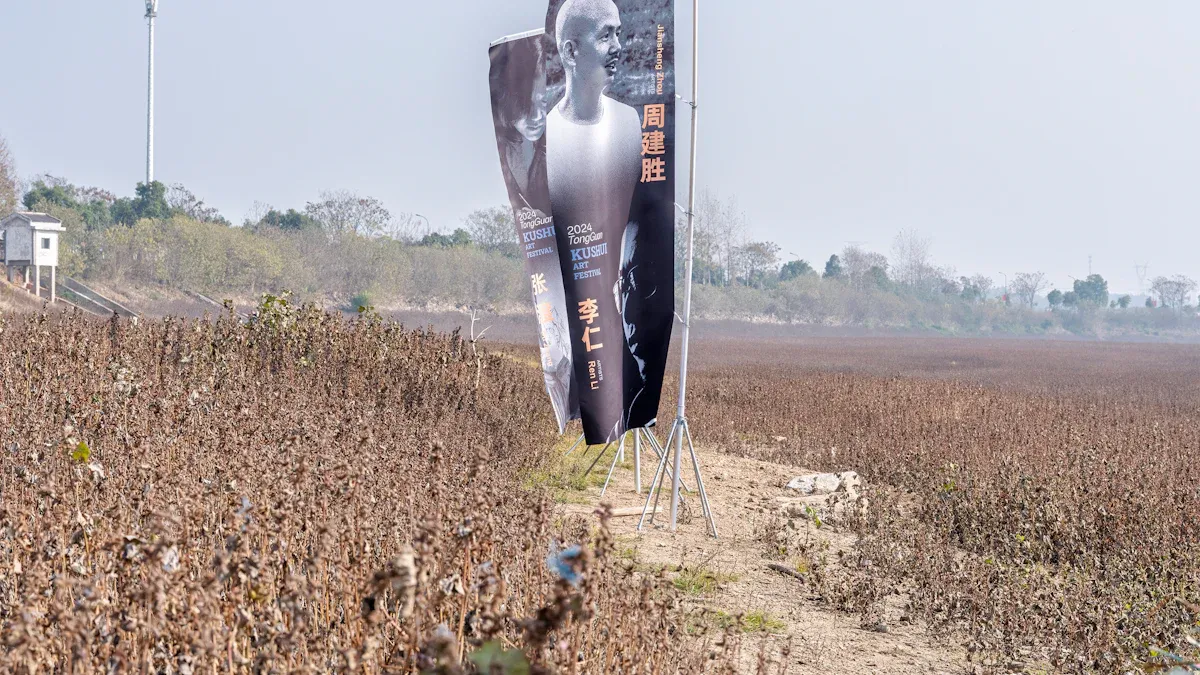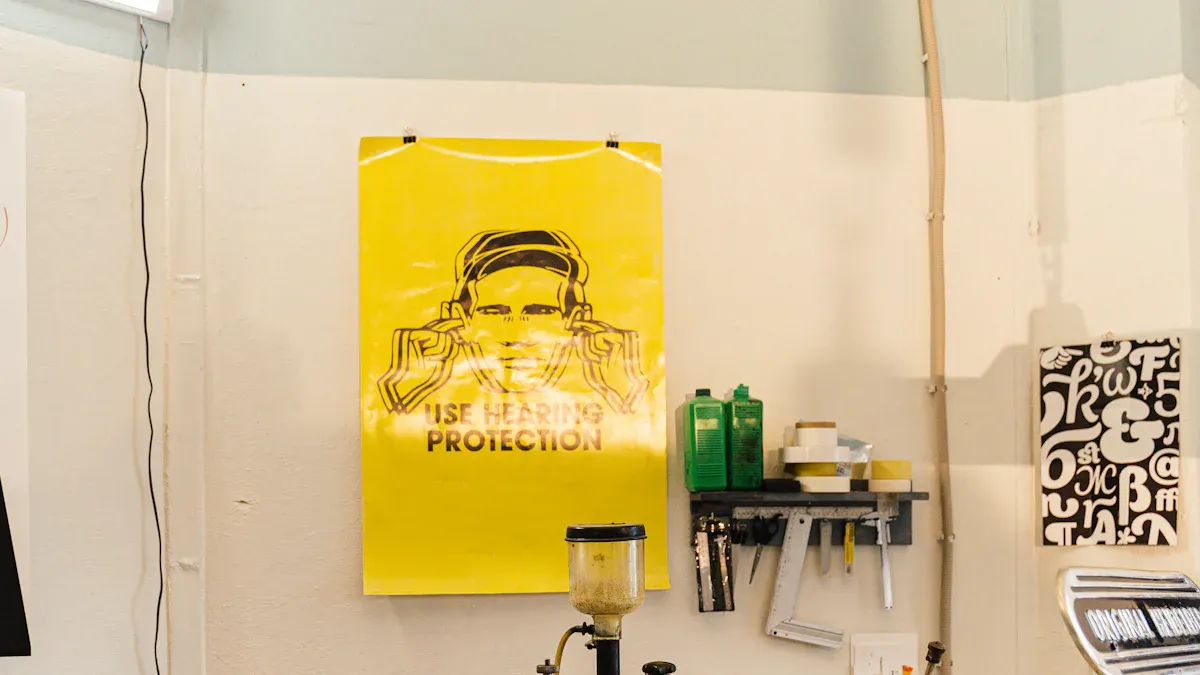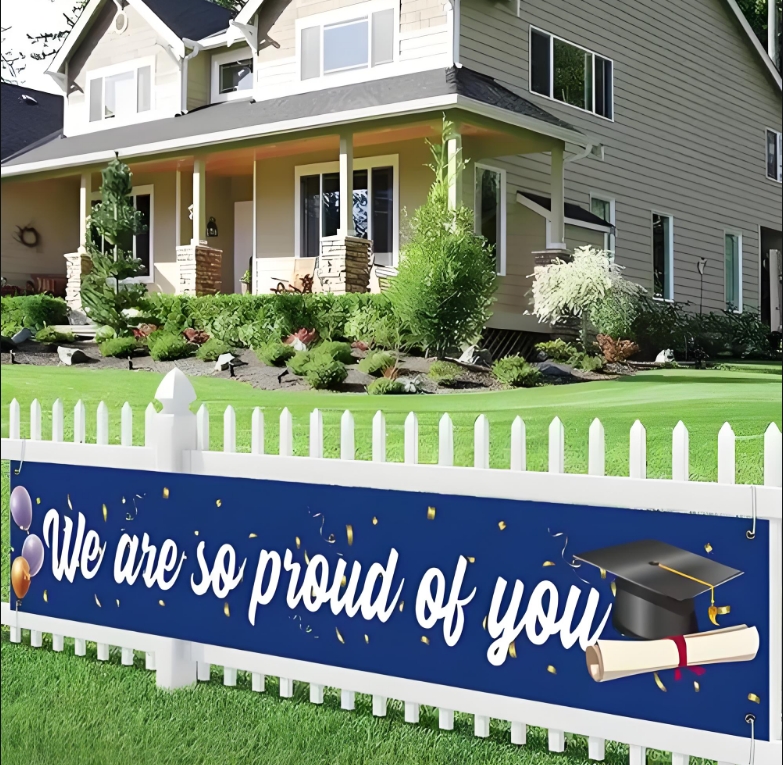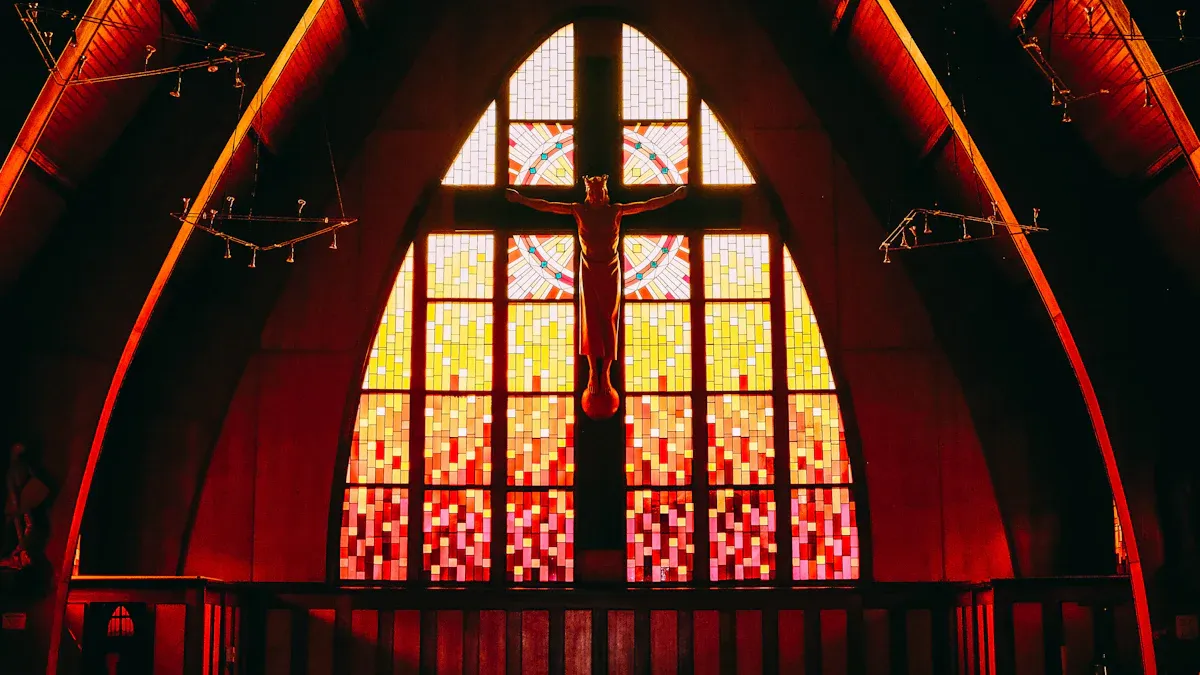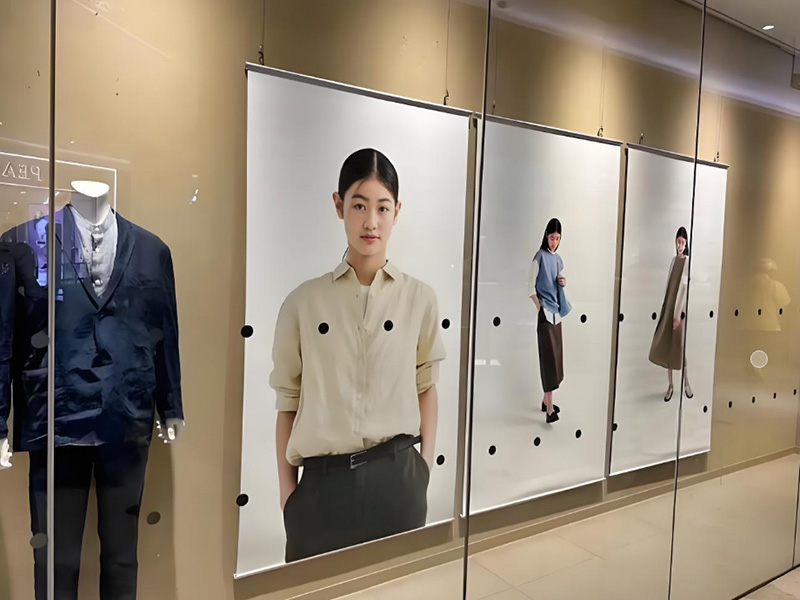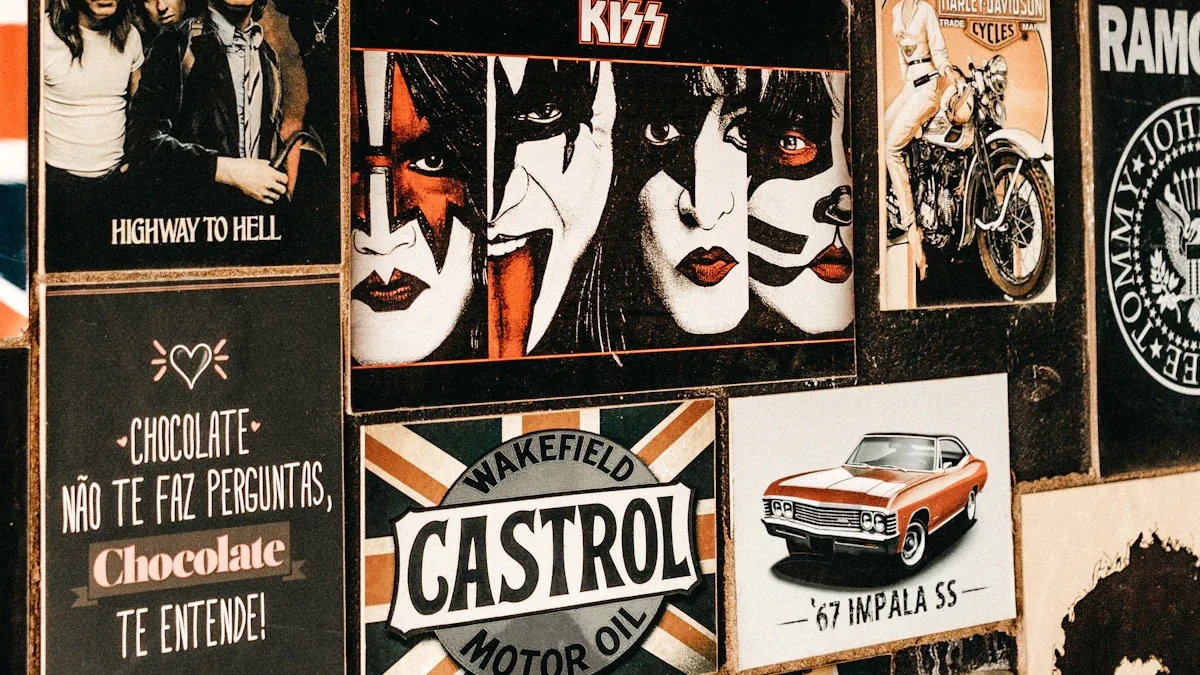
Billboards, banners, posters, and signboards help share messages with people. A billboard is a big outdoor sign that grabs attention. It is often placed on highways or busy streets. Banners are flexible signs made of fabric or vinyl. They are often used for events or promotions. Posters are printed pictures or designs, usually smaller, used indoors or outdoors. Signboards are sturdy signs that give clear and lasting messages. They are often seen outside stores or businesses.
These tools are important for ads and communication. For example, 71% of drivers see billboards while driving. This makes them great for reaching many people. Each type has its own use. They help you connect with your audience in creative ways.
Key Takeaways
Billboards are big outdoor signs that many people see, especially drivers.
Banners are light and easy to move, great for short events.
Posters are smaller signs with details, best for indoor use.
Signboards are strong and last long, good for business names or directions.
Pick the right sign based on your goals, audience, and place.
Bright colors and simple designs make ads stand out and be remembered.
Knowing what your audience likes can make your ads work better.
Planning your budget is important; different ads cost and help differently.
What Is a Billboard?
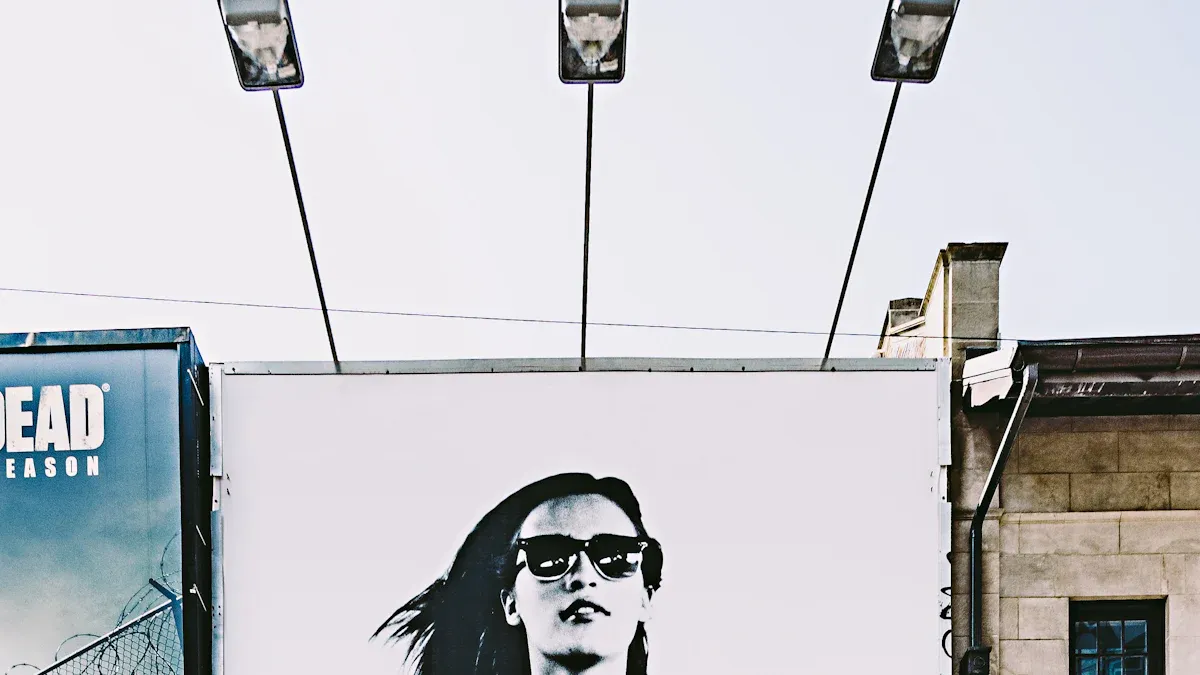
Definition and Characteristics
A billboard is a big outdoor sign made to grab attention. You often see them on highways, busy roads, or in cities. They are placed high up so people can see them easily. Billboards come in different types like still, digital, and moving ones. Still billboards show one picture or message. Digital billboards use LED screens to show changing content. Moving billboards are put on vehicles to reach more people.
One important thing about billboards is their size. They are much bigger than other ads, so they stand out. They are placed in busy areas to be seen by many people. Also, billboards are made strong to handle bad weather and last a long time.
Common Uses in Advertising
Billboards are very useful for advertising. They help spread the word about brands, products, or services to many people. Companies use them to share new products, announce sales, or give public messages.
Here are some ways billboards are measured for success:
Impressions: How many people see the billboard.
Reach: How many different people pass by it.
Brand Lift: How much more people know about the brand after seeing it.
Engagement: Actions like visiting a website or social media after seeing the ad.
Sales Lift: More sales that happen because of the billboard.
For example, the “Got Milk?” campaign used simple billboards to connect with people emotionally. In Times Square, digital billboards show how moving ads can stand out in crowded places.
Advantages of Billboards
Billboards have many benefits compared to other ads. Their large size and good locations make them easy to notice. Studies show 71% of drivers see at least one billboard while driving. This makes them great for reaching lots of people.
Digital billboards are especially effective. Research shows 46% to 84% of people respond to digital billboard ads. Also, 82% of people remember a digital ad they saw even a month later. This shows how strong billboard ads can be.
Here’s a table with some key facts:
Statistic | Description |
|---|---|
71% | People who see at least one billboard while driving. |
98% | Adults in the US who traveled in a car last month. |
38%-86% | How well outdoor ads, like billboards, get responses. |
46%-84% | How well digital billboards get responses. |
37% | Travelers who look at outdoor ads most of the time. |
Billboards also make people act quickly. A study found people who see outdoor ads are 17% more likely to check out the brand on their phones. This makes billboards a great way to get people interested and increase sales.
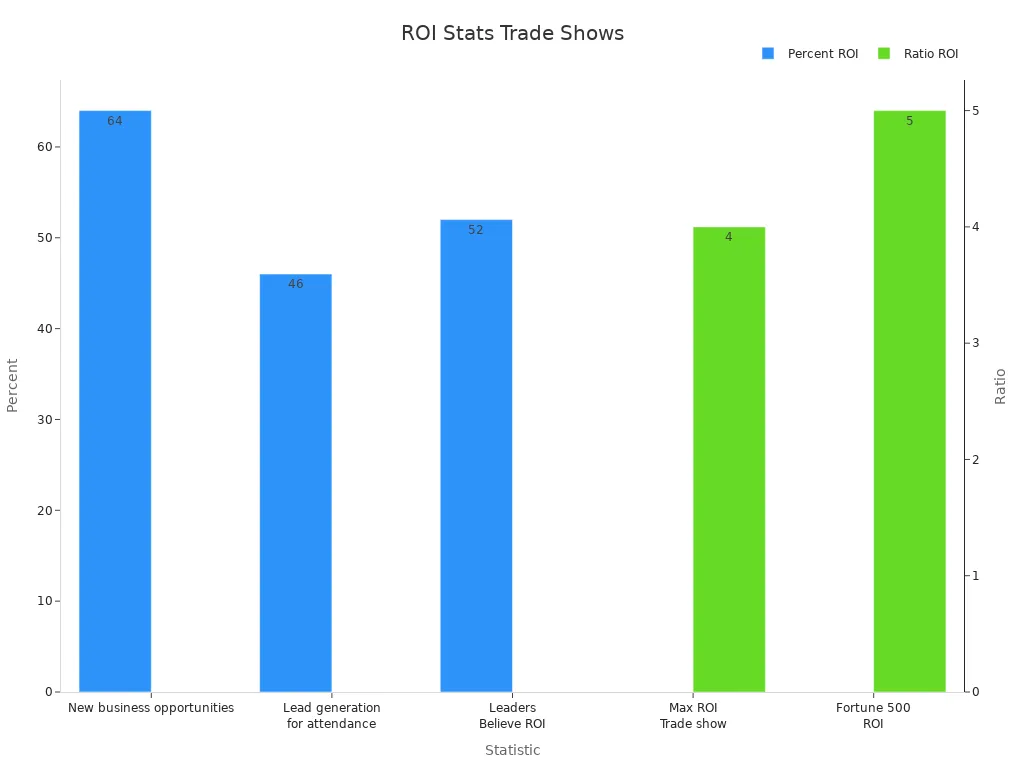
What Are Banners, Posters, and Signboards?
What Is a Banner?
A banner is a flexible sign made from fabric or vinyl. It shows messages, logos, or ads for events or sales. Banners are light and easy to carry, so they’re great for short-term use. You can hang them on walls, poles, or across streets to grab attention.
Banners come in many shapes and sizes. Some are long and horizontal, while others stand tall, like roll-up banners. Digital banners, which use LED screens, are popular for indoor events. Their flexibility makes banners a top choice for promoting brands or events.
What Is a Poster?
A poster is a printed sign that shares a message with pictures. Posters are smaller than banners and are often used inside. You might see them on walls, bulletin boards, or shop windows. They are made from paper, so they’re cheap and easy to make in large numbers.
Posters are great for giving detailed information. For example, a movie poster might show the title, date, and actors. Educational posters mix pictures and words to explain ideas. Their small size lets you put them in busy places where people can stop and look.
What Is a Signboard?
A signboard is a strong, lasting sign that shows ads or info. Businesses use signboards to display their name, logo, or services. You’ll see them outside stores, restaurants, or offices to guide customers.
Signboards are made from tough materials like wood or metal. This helps them last through bad weather for years. Some signboards have lights or digital screens to be seen at night. Their main job is to give clear, lasting messages to attract people.
Fun Fact: Outdoor ads like banners, posters, and signboards work well. Studies say they get people to respond 38% to 86% of the time. This makes them a smart choice for businesses to connect with customers.
Medium | Material Used | Common Purpose |
|---|---|---|
Banners | Fabric/Vinyl | Short-term events or promotions |
Posters | Paper/Cardstock | Indoor ads or learning tools |
Signboards | Wood/Metal | Long-term business signs |
Each type of sign has its own job in advertising. Whether you need something short-term, detailed, or long-lasting, there’s an option for you.
Key Features of Each Medium
Every advertising type has special traits for different uses. Knowing these traits helps you pick the best one.
Billboards
Billboards are big and easy to notice. They are made to catch attention from far away. You often see them on highways or in busy cities. They are strong enough to handle bad weather. Digital billboards can show many messages on one screen.
Key Features of Billboards:
Size: Big enough to be seen from far away.
Placement: Found in busy spots for more views.
Durability: Built to last through tough weather.
Impact: Great for making a bold statement.
Tip: Use bright colors and simple words to make your billboard stand out.
Banners
Banners are light and easy to move. They are perfect for short-term events or sales. Setting them up and taking them down is simple. Banners come in different shapes, like roll-up or hanging styles.
Key Features of Banners:
Material: Made from fabric or vinyl for flexibility.
Portability: Easy to carry and set up.
Versatility: Works indoors and outdoors.
Cost-Effectiveness: Affordable for short-term use.
Fun Fact: Banners are popular at trade shows because they are reusable and customizable.
Posters
Posters are smaller and have more details. They are great for places where people stop to read, like shop windows. Posters are printed on paper, so they are cheap to make in large numbers.
Key Features of Posters:
Size: Small and fits in tight spaces.
Detail: Can include more text and pictures.
Affordability: Low-cost for bulk printing.
Purpose: Perfect for sharing info or promoting events.
Note: Use bold images and short text to grab attention.
Signboards
Signboards are strong and last a long time. Businesses use them to show their name or services. They are placed outside stores to attract customers. Some have lights or digital screens for nighttime visibility.
Key Features of Signboards:
Material: Made from tough materials like wood or metal.
Longevity: Built to last for years outdoors.
Clarity: Gives a clear and lasting message.
Customization: Can include lights or digital designs.
Pro Tip: Place your signboard where people can easily see it.
Medium | Key Feature | Best Use Case |
|---|---|---|
Billboards | Big and weatherproof | Long-term, high-traffic ads |
Banners | Light and reusable | Short-term events or promotions |
Posters | Small and detailed | Indoor ads or learning tools |
Signboards | Strong and clear | Business signs or directions |
Each type has its own strengths. By learning about them, you can choose the one that fits your needs best.
Differences Between Billboards, Banners, Posters, and Signboards
Size and Scale
The size of an ad affects how people notice it. Billboards are the biggest and can be seen from far away. They are great for highways and busy city areas. Banners are smaller and easy to move, often used for events or sales. Posters are even smaller and usually placed indoors, like on walls or boards. Signboards are medium-sized and often found outside stores or along streets.
Pick the right size based on your audience and location. For example:
Use billboards to reach drivers on highways.
Posters work well in classrooms or shop windows.
The size should match the place to work best.
Material and Durability
The material of an ad decides how long it lasts. Billboards are made from strong vinyl or metal to handle bad weather. Banners use vinyl or mesh, making them flexible and durable for indoor or outdoor use. Posters are printed on paper, so they don’t last long and are best for short-term ads. Signboards are made from wood, metal, or plastic, making them strong and long-lasting.
Good materials save money and keep ads looking nice. For example:
Strong materials mean fewer replacements.
Neat displays make brands look better.
Choose materials based on where and how long you’ll use the ad. For outdoor ads, pick weatherproof options to keep them visible.
Placement and Visibility
Where you place an ad decides how many people see it. Billboards are placed in busy areas like highways or city centers to get noticed. Research shows that ads in these spots are remembered more. Banners and posters are smaller and placed at eye level where people can stop and read them. Signboards are put outside businesses to guide customers and grab attention.
Knowing traffic and crowd patterns helps pick the best spot. For example:
Busy areas help more people see your ad.
Messages aimed at certain groups work better at the right time.
Study your audience and location to place your ad where it will have the most impact.
Cost and Budget Considerations
When planning ads, knowing costs and budgets is important. Each type—billboards, banners, posters, and signboards—has different prices. Picking the right one depends on your goals and money.
Why Budget Planning Matters
Planning your budget helps you reach goals without overspending. A good plan lets you:
Set clear goals for your campaign.
Spend enough to meet your needs.
Avoid wasting money while getting good results.
For example, knowing how much it costs to reach one person helps you plan better. This way, every dollar you spend helps your campaign succeed.
Comparing Costs Across Mediums
Ad costs depend on size, material, and where they’re placed. Here’s a comparison:
Medium | Average Cost Range (USD) | Key Cost Factors |
|---|---|---|
Billboards | $1,500–$30,000/month | Location, size, and digital features |
Banners | $50–$500 | Material, size, and design |
Posters | $10–$100 | Printing quality and quantity |
Signboards | $200–$5,000 | Material, lighting, and durability |
Billboards cost more but are great for busy areas. Banners and posters are cheaper, good for short-term ads. Signboards cost more than posters but last longer.
Balancing Cost and Reach
To use your budget well, balance cost with how many people see your ad. For example:
Billboards are great for big crowds in cities.
Posters and banners work for smaller groups in specific places.
Signboards bring in local customers and last a long time.
Research helps you decide. Look at data to find the best spots and styles for your audience. This ensures your money reaches the right people.
Tips for Budget Optimization
Smart planning helps you use your money wisely. Try these tips:
Test small campaigns before spending more.
Plan for design, production, and ongoing costs.
Predict your return on investment (ROI) to focus on what works best.
A study shows 96% of outdoor advertisers are happy with their ROI. This proves that matching your budget to your goals leads to success.
By understanding costs and planning well, you can create ads that work without overspending.
Practical Applications of Each Medium
When to Use Billboards
Billboards are great for reaching many people in busy areas. They are perfect for promoting products or services to drivers or city pedestrians. Their large size makes them easy to notice from far away. Use billboards when you want to make a big impact or build brand awareness.
For instance, 71% of people said they saw at least one billboard while driving. This shows how well billboards work for reaching commuters. Even though billboards make up less than 3% of ad spending in North America, they still have a big effect. During the pandemic, billboard ads dropped by 12% in 2020 but grew by 16% in 2021. This proves their importance in advertising.
Tip: Use billboards for long-term campaigns or to reach large groups in cities or suburbs.
When to Use Banners
Banners are best for short-term events, sales, or seasonal promotions. They are lightweight and easy to move, making setup and removal simple. You can use banners indoors at trade shows or outdoors at local events. They are also great for highlighting discounts or special deals.
Knowing your audience helps you decide when to use banners. For example, banners at a farmers’ market can attract people looking for fresh food. Companies that focus on their audience’s needs often see better results. This shows that banners can be very effective when used correctly.
Pro Tip: Pick bright colors and clear fonts to make your banner stand out.
When to Use Posters
Posters are great for sharing detailed information in places where people stop to read. Use them to promote events, teach ideas, or advertise products in schools, offices, or stores. Posters are affordable and easy to print in large numbers, making them ideal for small budgets.
For example, a movie poster can show the title, release date, and actors all at once. Posters are also useful for teaching, like showing health tips in clinics or safety rules at work. By placing posters in busy indoor spots, you can make sure your message reaches the right people.
Note: Use eye-catching images and short text to grab attention fast.
When to Use Signboards
Signboards are great for sharing clear messages that last. They work well for businesses, events, or places needing long-term visibility. Use them to show your business name, promote services, or guide people. Their strong build makes them useful for years, even outdoors.
Perfect for Business Branding
Signboards help businesses stand out and get noticed. Putting one outside your store or office makes your brand easy to recognize. For example, a restaurant can use a bright signboard to attract customers at night. A good signboard catches attention and leaves a strong impression.
Tip: Use big letters and bold colors so your signboard is easy to read.
Effective for Directions and Guidance
Signboards are great for helping people find their way. Use them to show parking spots, entrances, or event locations. For instance, a wedding venue can use pretty signboards to guide guests to the ceremony. Clear signs make it easier for people to know where to go.
Best for Long-Term Advertising
Signboards are a smart choice for ads that last a long time. Unlike banners or posters, they stay useful for years. They are perfect for outdoor ads in busy areas. For example, a gas station can use a tall, lit-up signboard to attract drivers from the road.
Pro Tip: Choose strong materials like metal or acrylic to keep your signboard looking good.
Ideal for Local Promotions
Signboards are great for reaching local customers. Place them near your business or in community areas to connect with nearby people. For example, a bakery can use a sidewalk signboard to show daily specials. This helps bring in more customers and increase sales.
Use Case | Example | Key Benefit |
|---|---|---|
Business Branding | Storefront signboards | Makes your brand noticeable |
Directions | Event or parking signs | Helps people find their way |
Long-Term Ads | Highway or roadside signboards | Stays visible for years |
Local Promotions | Sidewalk or community signboards | Brings in nearby customers |
Signboards are strong and flexible, making them great for ads and communication. With the right design and spot, they can help your message reach the right people.
Design Tips for Effective Advertising
Key Elements of Billboard Design
Billboards need to grab attention fast. Keep the design simple. Focus on one main idea without adding too much. Use big, bold letters that are easy to read. Sans-serif fonts are the best choice for clear text. Bright colors with strong contrast make the billboard stand out, especially outdoors.
The famous ‘Got Milk?’ campaign used a smart design. It connected with people and became a memorable ad success.
Here are some tips to make your billboard better:
Use emotional words to connect with viewers.
Place billboards in busy areas for more views.
Adding pictures can improve your billboard. Use clear, high-quality images that match your message. Funny or interesting visuals can make people remember your ad. For example, a clever picture with a short phrase can leave a strong impression.
Tips for Creating Eye-Catching Banners
Banners are flexible but must catch attention quickly. Keep the design neat and simple. Use bright colors and bold letters to make your message clear. A clean layout helps people understand your banner fast.
Tell a story to make your brand feel personal.
Use sharp, high-quality pictures to stand out.
Add humor or unique ideas to make your banner memorable.
Where you place your banner is important. Hang it where people can see it easily, like at eye level or in busy spots. For roll-up banners at events, make sure the design is visible from far away. Always include your logo and contact details to promote your brand.
Pro Tip: Check your banner from different distances. This ensures your message stays clear and easy to read.
Best Practices for Poster Design
Posters can share more details but still need to look good. Use bold pictures and short text to grab attention. A strong title can pull people in, while smaller text gives extra details.
Balance the layout with enough empty space to avoid clutter.
Use contrasting colors to highlight important parts.
Add a clear action step, like a website or event date.
Posters work well in places where people stop, like shop windows or bulletin boards. To make your poster stronger, use storytelling. A powerful image with an emotional message can connect better with viewers.
Note: Track how well your poster works by checking views or responses. This helps you improve future designs.
By using these tips, you can create ads that catch attention and stay in people’s minds.
How to Create Effective Signboards
Making a signboard that stands out needs good planning. A great signboard can bring in customers, give directions, or promote your business. Follow these tips to design a signboard that works well.
Keep It Simple
Make your design clean and easy to read. A messy signboard can confuse people and lose its purpose. Use a clear layout with little text. Focus on one main idea. For example, a bakery sign could say, “Fresh Bread Daily” with a bread picture.
Tip: Use seven words or fewer for quick reading.
Pick the Right Colors
Colors help grab attention fast. Bright and contrasting colors make your signboard noticeable. Match the colors to your brand. For example, a coffee shop might use warm colors like brown and beige. Don’t use too many colors, as it can look messy.
Color Type | What It Does |
|---|---|
Bright Colors | Catches attention quickly |
Warm Tones | Feels friendly and inviting |
High Contrast | Easier to read from far away |
Use Clear and Bold Fonts
The font you pick affects how easy it is to read. Use bold, simple fonts like sans-serif for better visibility. Avoid fancy fonts that are hard to read from far away. Make sure the text is big enough to see clearly.
Pro Tip: Check your font by looking at it from 20 feet away.
Add Attractive Visuals
Pictures or icons can make your signboard more interesting. Use clear, high-quality images that match your message. For example, a pizza shop could show a slice of pizza. Don’t add too many pictures, as they can distract from the main idea.
Place It Correctly
Where you put your signboard is very important. Place it at eye level or in busy areas with lots of people or cars. Make sure nothing blocks it, like trees or poles. A good spot makes your signboard more effective.
Note: Check the location at different times of the day to ensure it’s always visible.
Add a Call-to-Action
Encourage people to act by adding a call-to-action (CTA). Words like “Visit Us Today” or “Call Now” can inspire action. Put the CTA where it’s easy to see.
By using these tips, you can make a signboard that is clear and memorable. A well-made signboard not only grabs attention but also helps your message reach the right people.
Choosing the Right Medium for Your Campaign
Setting Your Advertising Goals
Your goals decide the best medium for your campaign. First, figure out what you want to achieve. Do you want more people to know your brand? Are you promoting a product or trying to bring customers to your store? Each type of ad works differently.
Billboards: Best for reaching lots of people and building awareness.
Banners: Great for short-term events or promotions.
Posters: Useful for sharing details in small spaces.
Signboards: Good for lasting messages and guiding customers.
Matching your campaign to customer needs makes it more effective. Personalizing your message helps it connect with your audience. Tracking how well your campaign works (ROI) lets you focus on what brings the best results.
Using data is key to successful outdoor ads. It helps pick the right locations and create targeted messages with technology and analytics.
Knowing Your Audience
Understanding your audience helps you pick the right ad type. Think about who you want to reach and where they spend time. Are they drivers, shoppers, or event visitors? Different ads work better for different groups.
Billboards: Reach people driving or walking in busy areas.
Banners: Catch attention at events or trade shows.
Posters: Share info in schools, stores, or offices.
Signboards: Attract local customers near your business.
Data helps you make smarter choices by showing how people behave and what they like. It also shows which locations work best for your ads. This ensures your message reaches the right audience.
Advertisers can track billboard success using QR codes, social media, and location tools. These methods show how well ads perform, including clicks, brand awareness, and sales.
Planning Your Budget
Your budget affects which ad type you can use. Each option costs differently, so plan wisely.
Billboards: Cost more but work well for big campaigns.
Banners: Cheaper and reusable for short-term ads.
Posters: Low-cost and easy to print in large numbers.
Signboards: Strong and affordable for long-term use.
New tools like AI and data analytics are changing outdoor ads. They help companies target audiences better and spend money wisely. By studying market trends, you can decide where to invest your budget for the best results.
AI makes outdoor ads smarter by helping advertisers focus on specific groups. This data-driven method improves ad choices and ensures resources are used effectively.
Evaluating the Location and Context
Where you place your ad is very important. The location decides how many people see it. It also affects how well your ad connects with the audience. Knowing the area and how people behave helps you choose wisely.
Why Location Matters
Picking the right spot helps your ad reach the right people. For example, a billboard on a busy highway is seen by many drivers. A poster in a school hallway is perfect for students and teachers. Each type of ad works best in certain places.
Here’s how different ads match with locations:
Medium | Best Location Example | Audience Type |
|---|---|---|
Billboards | Highways, city centers | Commuters, urban dwellers |
Banners | Trade shows, local events | Event attendees, shoppers |
Posters | Schools, offices, shop windows | Students, employees, customers |
Signboards | Storefronts, busy streets | Local customers, passersby |
Tip: Check how many people pass by your chosen spot to get the most views.
The Role of Context
Context means the surroundings and timing of your ad. It includes things like the mood of people and the purpose of the place. For example, a bright banner at a festival feels fun. A simple signboard outside a law office looks professional.
Make sure your ad fits the area. A flashy digital billboard works in Times Square but might not suit a quiet neighborhood. Matching your ad’s style to the place helps it connect better with viewers.
Questions to Ask Before Choosing a Location
Who are you trying to reach?
Where do they spend their time?
What is the purpose of the place?
How busy is the area?
Does the location match your brand’s message?
Answering these questions helps you find the best spot for your ad.
Pro Tip: Visit the spot at different times to see how lighting and crowds change. This helps you pick the best placement.
By thinking about both location and context, your ad can stand out and make a strong impression.
Billboards, banners, posters, and signboards are used for different goals. Billboards are great for reaching many people. Banners are best for short-term ads or events. Posters share detailed information in small spaces. Signboards give clear messages that last a long time. Picking the right type helps your message reach the audience better.
Studies show 71% of drivers notice billboards, and 89% think they work well. This shows how important good placement and bold designs are.
To make ads work better, study traffic flow and use creative ideas. Track how many people see your ad and how they respond. These steps improve your plan and get better results.
FAQ
What is the main difference between billboards and banners?
Billboards are big outdoor ads that stay in one place. Banners are smaller, easy to move, and used for short-term events.
Can you reuse banners for multiple events?
Yes, banners made from strong materials like vinyl can be reused. Make sure the design works for different events.
How do posters differ from signboards?
Posters are light and made of paper, good for short-term use. Signboards are tough, made of wood or metal, and last longer outdoors.
Are digital billboards more effective than traditional ones?
Digital billboards show changing messages and grab attention with motion. They work well in busy areas but cost more than regular billboards.
What materials work best for outdoor signboards?
Metal, treated wood, and acrylic are great for outdoor signboards. These materials are strong and resist weather damage.
How do you decide where to place a billboard?
Pick busy places like highways or city centers. Study your audience and make sure the spot fits your campaign goals.
Are posters suitable for outdoor use?
Posters can be used outside if printed on weatherproof materials. But they are better indoors because they don’t last as long.
What makes a banner design effective?
A good banner has clear text, bright colors, and simple fonts. Make sure it’s easy to read from far away and matches your brand.
Tip: Check your ad design from different distances to make sure it’s clear and stands out.


